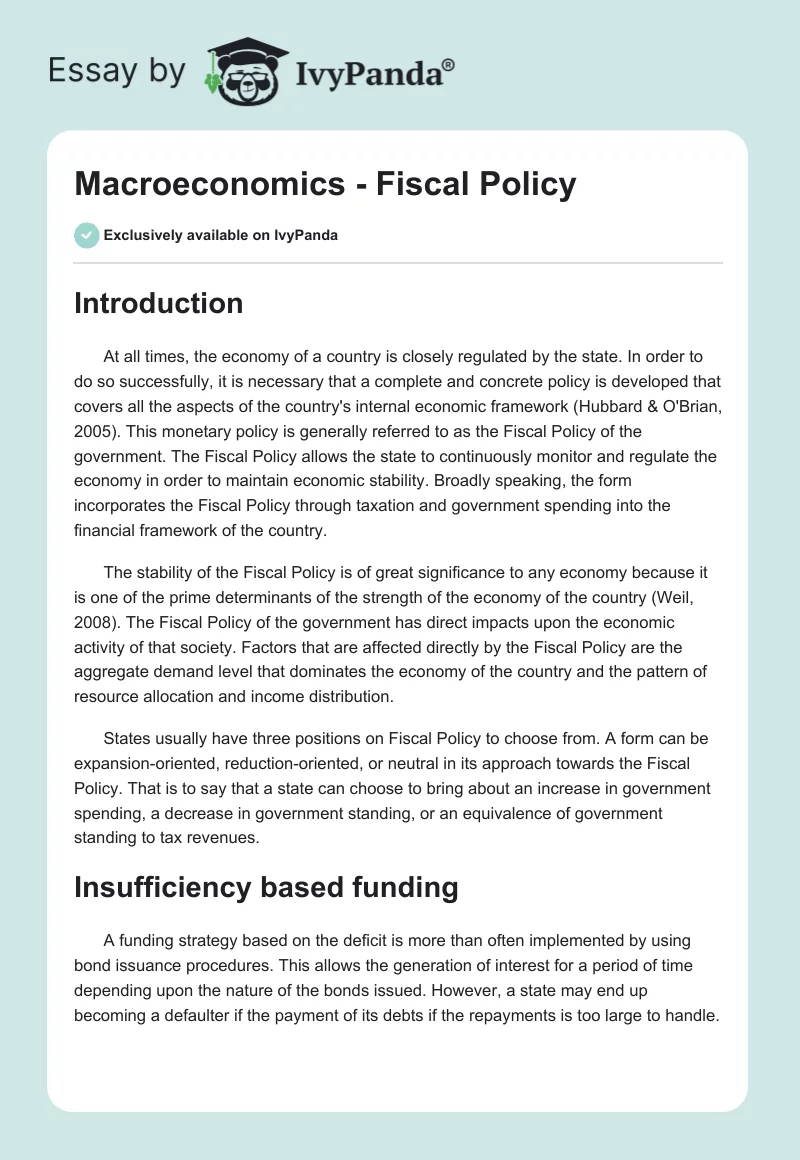Introduction
At all times, the economy of a country is closely regulated by the state. In order to do so successfully, it is necessary that a complete and concrete policy is developed that covers all the aspects of the country’s internal economic framework (Hubbard & O’Brian, 2005). This monetary policy is generally referred to as the Fiscal Policy of the government. The Fiscal Policy allows the state to continuously monitor and regulate the economy in order to maintain economic stability. Broadly speaking, the form incorporates the Fiscal Policy through taxation and government spending into the financial framework of the country.
The stability of the Fiscal Policy is of great significance to any economy because it is one of the prime determinants of the strength of the economy of the country (Weil, 2008). The Fiscal Policy of the government has direct impacts upon the economic activity of that society. Factors that are affected directly by the Fiscal Policy are the aggregate demand level that dominates the economy of the country and the pattern of resource allocation and income distribution.
States usually have three positions on Fiscal Policy to choose from. A form can be expansion-oriented, reduction-oriented, or neutral in its approach towards the Fiscal Policy. That is to say that a state can choose to bring about an increase in government spending, a decrease in government standing, or an equivalence of government standing to tax revenues.
Insufficiency based funding
A funding strategy based on the deficit is more than often implemented by using bond issuance procedures. This allows the generation of interest for a period of time depending upon the nature of the bonds issued. However, a state may end up becoming a defaulter if the payment of its debts if the repayments is too large to handle.
Surplus utilization
When a surplus is observed, the state often chooses to save up the attained excess to bring into use in case it becomes the requirement of a future scenario in which the state finds itself. Surplus saved through this technique has usually been observed to be brought into use when income rolling in from taxes and other similar channels falls short of the required amount. If saving has not been previously made, the state can run into a deficit unless the state reduces spending accordingly.
Although as effective and precise as it may sound, Fiscal Policy often comes under severe criticism from several classical and neoclassical economists. It is often said that fiscal policy does not have any direct effect as a stimulus on the economy of the country. This perspective is commonly referred to as the Treasury perspective (Badhwar, 2008). It entails that when a country is faced with a budget deficit, funds should be brought from foreign sources instead of local sources. Otherwise, a severe increase in the interest rate in the market will follow and is led by higher demand for credit in the market which eventually transpires into a decrease in aggregate demand, a crowding out of sorts.
Works Cited
Badhwar, R. (2008). A treasury perspective: effective responses to market risk. Web.
Hubbard, R., & O’Brian, A. (2005). Macroeconomics. Prentice-Hall.
Weil, D. (2008). Fiscal Policy.


